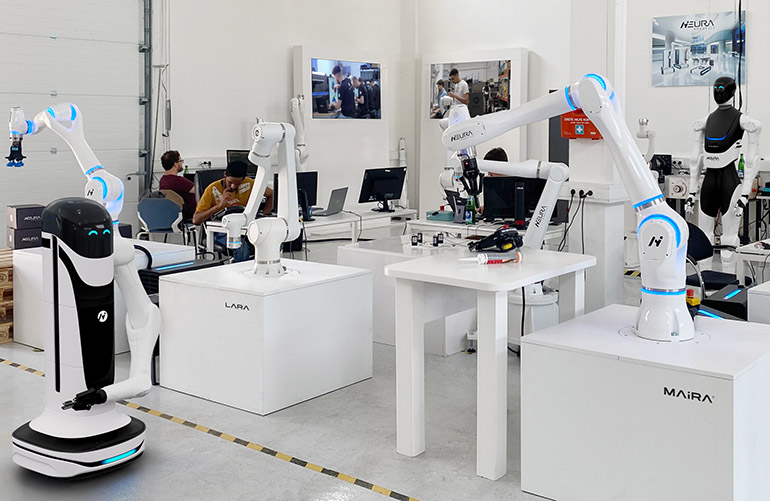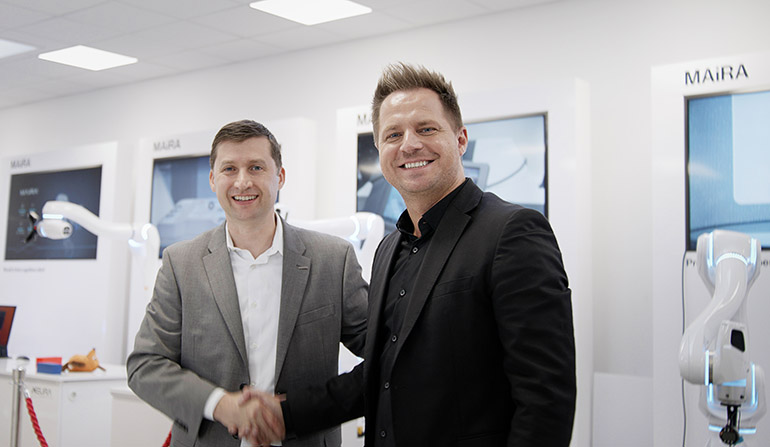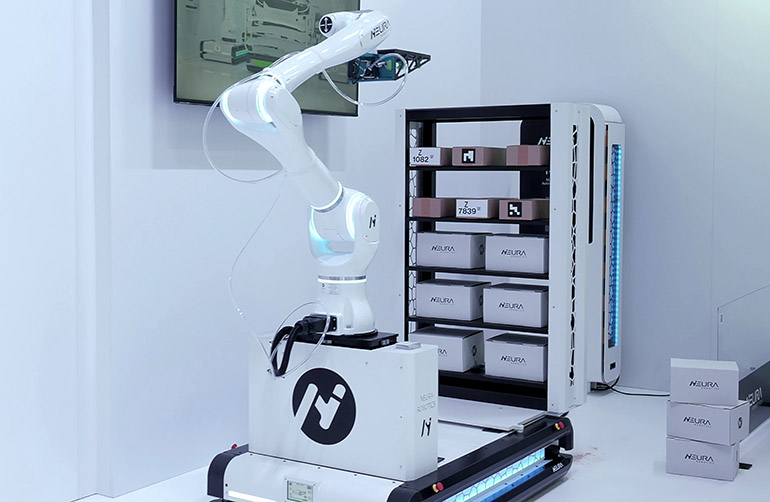|
Listen to this article |

NEURA has developed cognitive robots in a variety of form factors. Source: NEURA Robotics
Talk about combining robotics and artificial intelligence is all the rage, but some convergence is already maturing. NEURA Robotics GmbH and Omron Robotics and Safety Technologies Inc. today announced a strategic partnership to introduce “cognitive robotics” into manufacturing.
“By pooling our sensor and AI technologies and expertise into an ultimate platform approach, we will significantly shape the future of the manufacturing industry and set new standards,” stated David Reger, founder and CEO of NEURA Robotics.
Reger founded the company in 2019 with the intention of combining sensors and AI with robotics components for a platform for app development similar to that of smartphones. The “NEURAverse” offers flexibility and cost efficiency in automation, according to the company.
“Unlike traditional industrial robots, cognitive robots have the ability to learn from their environment, make decisions autonomously, and adapt to dynamic production scenarios,” said Metzingen, Germany-based NEURA. “This opens new application possibilities including intricate assembly tasks, detailed quality inspections, and adaptive material handling processes.”
Omron has sensor, channel expertise
“We see NEURA’s cognitive technologies as a compelling growth opportunity for industrial robotics,” added Olivier Welker, president and CEO of Omron Robotics and Safety Technologies. “By combining NEURA’s innovative solutions with Omron’s global reach and automation portfolio, we will provide customers new ways to increase safety, productivity, and flexibility in their operations.”
Pleasanton, Calif.-based Omron Robotics is a subsidiary of OMRON Corp. focusing on automation and safety sensing. It designs and manufactures industrial, collaborative, and mobile robots for various industries.
“We’ve known Omron for quite some time, and even before I started NEURA, we had talked about collaborating,” Reger told The Robot Report. “They’ve tested our products, and we’ve worked together on how to benefit both sides.”
“We have the cognitive platform, and they’re one of the biggest sensor, controllers, and safety systems providers,” he added. “This collaboration will integrate our cognitive abilities and NEURAverse with their sensors for a plug-and-play solution, which everyone is working toward.”

Omron Robotics’ Olivier Welker and NEURA’s David Reger celebrate their partnership. Source: NEURA
Collaboration has ‘no limits’
When asked whether NEURA and Omron Robotics’ partnership is mainly focused on market access, Reger replied, “It’s not just the sales channel … there are no really big limits. From both sides, there will be add-ons.”
Rather than see each other as competitors, NEURA and Omron Robotics are working to make robots easier to use, he explained.
“As a billion-dollar company, it could have told our startup what it wanted, but Omron is different,” said Reger. “I felt we got a lot of respect from Olivier and everyone in that organization. It won’t be a one-sided thing; it will be just ‘Let’s help each other do something great.’ That’s what we’re feeling every day since we’ve been working together. Now we can start talking about it.”
NEURA has also been looking at mobile manipulation and humanoid robots, but adding capabilities to industrial automation is the “low-hanging fruit, where small changes can have a huge effect,” said Reger. “A lot of things for humanoids have not yet been solved.”
“I would love to just work on household robots, but the best way to get there is to use the synergy between industrial robotics and the household market,” he noted. “Our MAiRA, for example, is a cognitive robot able to scan an environment and from an idle state pick any known or unknown objects.”

MAiRA cognitive robot on MAV mobile base. Source: NEURA Robotics
Ease of use drives NEURA strategy
NEURA and Omron Robotics promise to make robots easier to use, helping overall adoption, Reger said.
“A big warehouse company out of the U.S. is claiming that it’s already using more than 1 million robots, but at the same time, I’m sure they’d love to use many more robots,” he said. “It’s also in the transformation from a niche market into a mass market. We see that’s currently only possible if you somehow control the environment.”
“It’s not just putting all the sensors inside the robot, which we were first to do, and saying, ‘OK, now we’re able to interact with a human and also pick objects,’” said Reger. “Imagine there are external sensors, but how do you calibrate them? To make everything plug and play, you need new interfaces, which means collaboration with big players like Omron that provide a lot of sensors for the automation market.”
NEURA has developed its own sensors and explored the balance of putting processing in the cloud versus the edge. To make its platform as popular with developers as that of Apple, however, the company needs the support of partners like Omron, he said.
Reger also mentioned NEURA’s partnership with Kawasaki, announced last year, in which Kawasaki offers the LARA CL series cobot with its portfolio. “Both collaborations are incredibly important for NEURA and will soon make sense to everyone,” he said.
NEURA to be at Robotics Summit & Expo
Reger will be presenting a session on “Developing Cognitive Robotics Systems” at 2:45 p.m. EDT on Wednesday, May 1, Day 1 of the Robotics Summit & Expo. The event will be at the Boston Convention and Exhibition Center, and registration is now open.
“I’ll be talking about making robots cognitive to enable AI to be useful to humanity instead of competing with us,” he said. “AI is making great steps, but if you look at what it’s doing, like drawing pictures or writing stories — these are things that I’d love to do but don’t have the time for. But if I ask, let’s say, AI to take out the garbage or show it a picture of garbage, it can tell me how to do it, but it’s simply not able to do something about it yet.”
NEURA is watching humanoid development but is focusing on integrating cognitive robotics with sensing and wearables as it expands in the U.S., said Reger. The company is planning for facilities in Detroit, Boston, and elsewhere, and it is looking for leadership team members as well as application developers and engineers.
“We don’t just want a sales office, but also production in the U.S.,” he said. “We have 220 people in Germany — I just welcomed 15 new people who joined NEURA — and are starting to build our U.S. team. In the past several months, we’ve gone with only European and American investors, and we’re looking at the Japanese market. The U.S. is now open to innovation, and it’s an exciting time for us to come.”
 Learn from Agility Robotics, Amazon, Disney, Teradyne and many more.
Learn from Agility Robotics, Amazon, Disney, Teradyne and many more.
